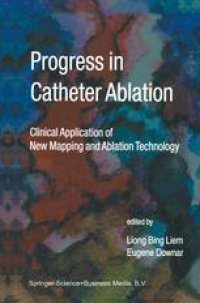
Ebook: Progress in Catheter Ablation: Clinical Application of New Mapping and Ablation Technology
- Tags: Cardiology, Biomedical Engineering
- Series: Developments in Cardiovascular Medicine 241
- Year: 2001
- Publisher: Springer Netherlands
- Edition: 1
- Language: English
- pdf
Catheter ablation is widely accepted as an effective and safe form of therapy for cardiac arrhythmia. In many instances this curative procedure is considered as the first line of therapy if not the ultimate treatment of choice. With the use of radiofrequency (RF) modality; which has revolutionized the technology from a barotraumatic, potentially injurious procedure using high voltage, direct-current (DC) shock to a safe and relatively painless one; catheter ablation procedure now carries a very low risk and is extremely effective for certain types of arrhythmia. Its efficacy rate in curing supraventricular tachycardia involving an accessory pathway or dual atrioventricular nodal pathways has been near perfect and its application for certain types of atrial and ventricular arrhythmia have also been very satisfactory. However, conventional RF ablation has several well known limitations, most notably is its ability to only produce relatively small, point lesions; rendering it effective only for an arrhythmia with a small and/or a superficial target. It was soon recognized that the technology would not likely to have significant utility in arrhythmia with a more widespread target such as atrial fibrillation or those which involve scarred and deep myocardial tissue such as ventricular tachycardia. Indeed, the application of conventional RF technology in these complex but common arrhythmia has yielded unsatisfactory results.
The clinician nowadays is faced with a wide and often confusing choice of new instruments and methods of ablation. There are few, if any, comparative studies involving the various new tools, nor is there any compilation of data on any specific new discovery. It is timely to provide a review of available data on the progress of new technology in order to enhance our knowledge and to concentrate our efforts into the development of an ultimate practical and yet effective methodology.
The purpose of this publication is to provide a forum in which the authors can present their experience, even if only in its preliminary stages, in the respective field or technology. Various technological advancements in mapping and ablation as well as the improved understanding of the pathophysiology of the various arrhythmias are presented. The authors are selected for their interest and expertise on the subject. Each topic is presented in a concise form and with relevance to the development of new technology. The authors are encouraged to provide their opinion on the issues to stimulate further discussion and investigation.